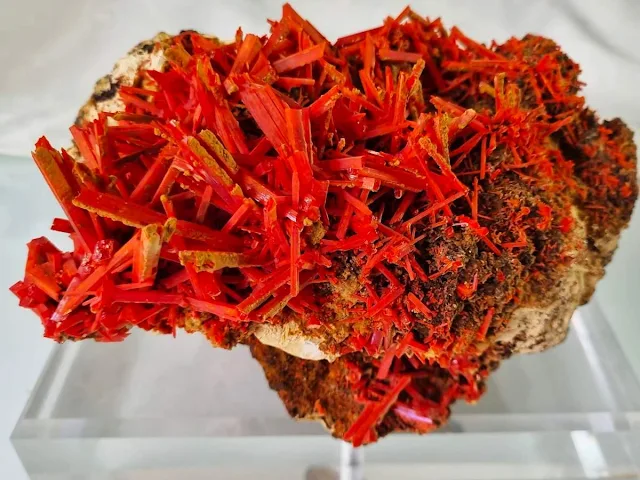Crocoite: Properties, Uses, Facts
Crocoite is a lead chromate mineral with a brilliant orange-red color. Crocoite is a highly toxic mineral and can be harmful if ingested or inhaled. It is also a fire hazard and can ignite spontaneously when exposed to heat. It is a rare mineral that is typically found in hydrothermal veins and oxidized lead deposits.
Crocoite Beautiful, Toxic Mineral
Crocoite provides a nice color to the mineral kingdom and is well known for its distinctive orange-red color. Its main source of quality specimens comes from the Dundas District of Tasmania, Australia.
Crocoite is a rare lead chromate, known in the oxidation zone of lead deposits, especially those located near ultra-basic chromium-rich rocks.
It was discovered at the Berezovskoe Au Deposit (Berezovsk Mines) near Ekaterinburg in the Urals in 1766; and named crocoise by F. S. Beudant in 1832, from the Greek κρόκος (krokos), saffron, in allusion to its color, a name first altered to crocoisite and afterwards to crocoite.
 |
| Crocoite from the Dundas extended mine, Dundas, Tasmania, Australia Photo: Henk Smeets/Tomeik Minerals. |
The relative rarity of crocoite is connected with the specific conditions required for its formation: an oxidation zone of lead ore bed and presence of ultramafic rocks serving as the source of chromium (in chromite). Oxidation of Cr3+ into CrO42− (from chromite) and decomposition of galena (or other primary lead minerals) are required for crocoite formation. These conditions are relatively unusual.
As crocoite is composed of lead(II) chromate, it is toxic, containing both lead and hexavalent chromium.
Properties of Crocoite
Composition: Crocoite is composed of lead chromate (PbCrO4). It contains lead, chromium, and oxygen.
Crocoite Physical Properties
- Color: Crocoite is known for its vibrant orange to red color. The intensity of the color can vary, and sometimes it may exhibit a yellow or brown tint.
- Transparency: Crocoite is typically transparent to translucent.
- Luster: The luster of crocoite is adamantine, giving it a shiny and reflective appearance.
- Crystal System: Crocoite crystallizes in the monoclinic crystal system.
- Streak: The streak of crocoite is orange-yellow.
- Hardness: Crocoite has a hardness of around 2.5 on the Mohs scale. This makes it relatively soft and susceptible to scratching.
- Cleavage: Crocoite lacks cleavage, meaning it does not break along distinct planes.
- Fracture: The mineral displays uneven to subconchoidal fracture.
- Habits and Forms: Crocoite often forms prismatic crystals that can be long and slender. These crystals are commonly found in clusters or as coatings on matrix rocks. It may also occur as acicular or needle-like crystals.
- Density: The density of crocoite is approximately 6.0 g/cm³.
- Specific Gravity: Crocoite has a specific gravity ranging from 6.05 to 6.1.
- Solubility: Crocoite is insoluble in water.
- Magnetism: Crocoite is not magnetic.
Crocoite Optical Properties
- Fluorescence: Crocoite is known to exhibit fluorescence under ultraviolet (UV) light. It may fluoresce yellow to orange.
- Pleochroism: Crocoite can show weak pleochroism, meaning it may display different colors when viewed from different angles, but this effect is not always pronounced.
- Refractive Index: The refractive index of crocoite ranges from approximately 2.3 to 2.4.
 |
| Crocoite crystals |
Crocoite Uses
Crocoite is a mineral composed of lead chromate, and it is primarily used as a source of chromium and as a specimen for mineral collectors due to its vibrant red color and unique crystal formations. Here are some of the main uses and applications of crocoite:
Mineral Collecting:
Crocoite is highly valued by mineral collectors and enthusiasts due to its striking red color and distinctive crystal habit. Collectors often seek out specimens for display in private collections or museums.
Chromium Ore:
Crocoite is a minor ore of chromium. Chromium is an essential metal used in the production of stainless steel, alloys, and various industrial applications. While crocoite is not a major source of chromium, it contributes to the overall availability of this important metal.
Pigments:
In the past, lead chromate, the primary component of crocoite, was used as a pigment in paints, dyes, and pigments. However, due to its toxicity, lead-based pigments have been largely replaced by safer alternatives in modern times.
Scientific Research:
Crocoite specimens are sometimes used in scientific research, particularly in geological and mineralogical studies. The unique crystal structures and mineral composition can provide insights into geological processes and conditions.
Jewelry and Ornamental Use:
While not as common as other gemstones, crocoite crystals may be used in jewelry or as ornamental stones. However, their relative softness and the presence of lead may limit their suitability for certain applications.
It's important to note that due to the presence of lead, precautions should be taken when handling crocoite specimens to avoid potential health hazards associated with lead exposure. As with any mineral or substance, it's advisable to be aware of safety considerations and handle them with care.
 |
| Crocoite crystals from the Red Lead Mine, Dundas, Tasmania, Australia Photo: Ingo Lange |
Collectors appreciate crocoite for its striking color and unique crystal formations. However, it is important to handle crocoite specimens with care, as they are somewhat fragile. Due to its lead content, it's advisable to wash hands after handling crocoite to prevent lead exposure.

%20(1).webp)






